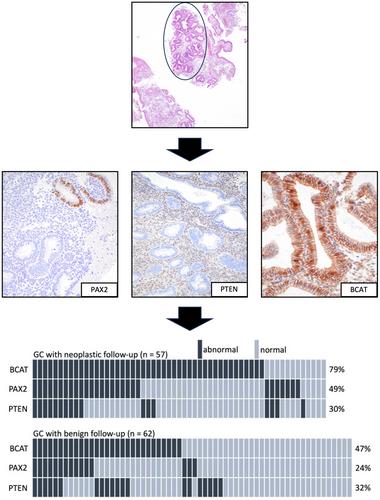Lesions sub-diagnostic of endometrioid intra-epithelial neoplasia/atypical hyperplasia: value of morphology and immunohistochemistry in predicting neoplastic outcome
Abstract
Aims
Areas of gland crowding that do not fulfil diagnostic criteria of endometrioid intra-epithelial neoplasia (EIN) are often encountered in endometrial biopsies. In this study, we document the prevalence of neoplastic outcome in patients with these subdiagnostic lesions (SL) and assess the utility of morphological features and a three-marker immunohistochemistry panel (PAX2, PTEN, beta-catenin) to predict outcome.
Methods and results
Of 430 women with SL on endometrial sampling at Brigham and Women's Hospital between 2001 and 2021 with available follow-up biopsy, 72 (17%) had a neoplastic outcome (EIN or endometrioid carcinoma). Multilayered epithelium and mitoses in SL were statistically associated with a neoplastic outcome. Abnormal three-marker staining was observed in 93% (53 of 57) of SL with neoplastic outcome and 60% (37 of 62) of a control group with benign outcome. Among the 72 patients with neoplastic outcome, EIN/carcinoma tissue was available in 33; of these, 30 (91%) showed abnormal staining for one or more markers. Remarkably, in 84% of these cases the EIN/carcinoma had the aberrant expression seen in the preceding SL. Based on a prevalence of 17%, the positive and negative predictive values of abnormal staining in one or more markers were 24 and 97%, respectively.
Conclusions
The presence of SL warrants clinical surveillance and repeat sampling because it is followed by endometrioid neoplasia in a significant subset of patients. Normal three-marker staining identifies women with a very low risk of neoplastic outcome. Conversely, abnormal staining is frequent in SL with benign outcome leading to poor specificity and positive predictive value.


 求助内容:
求助内容: 应助结果提醒方式:
应助结果提醒方式:


